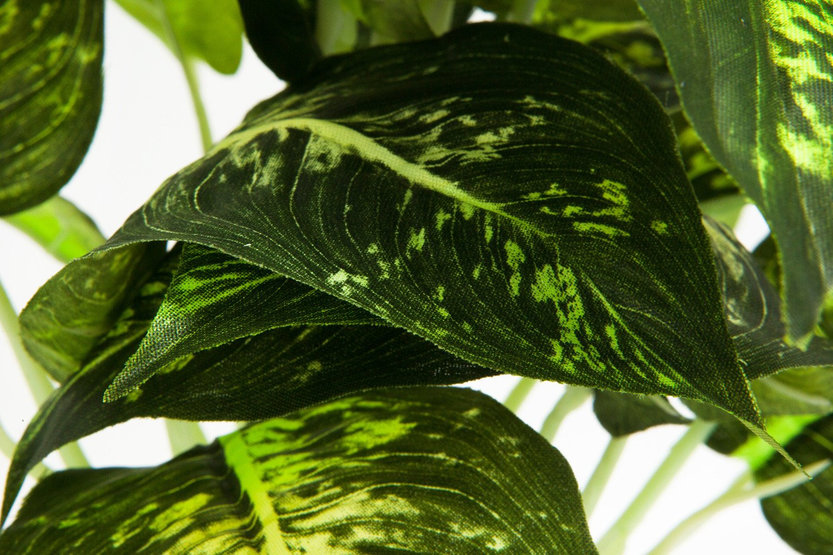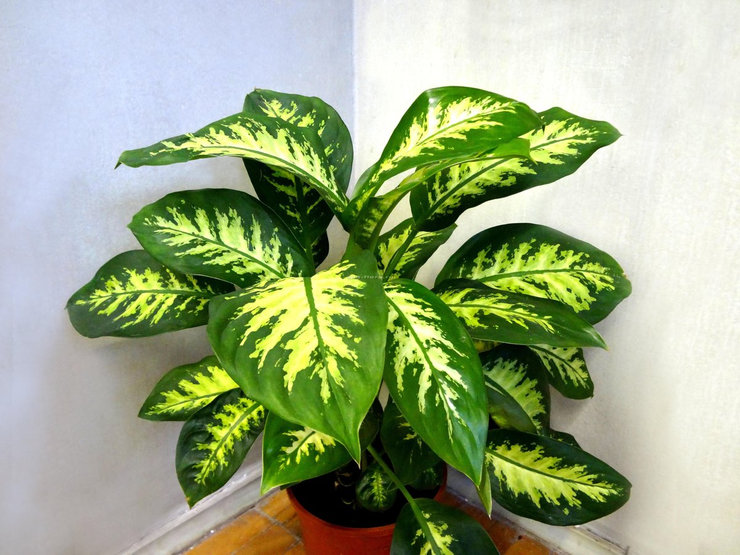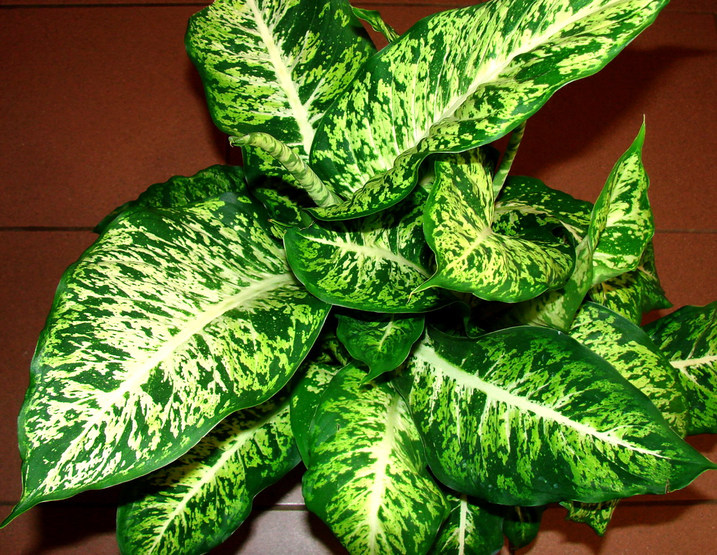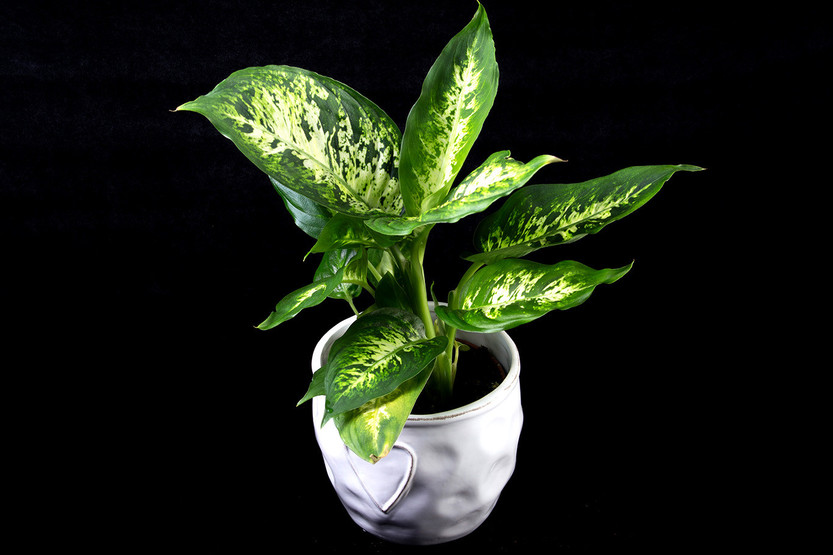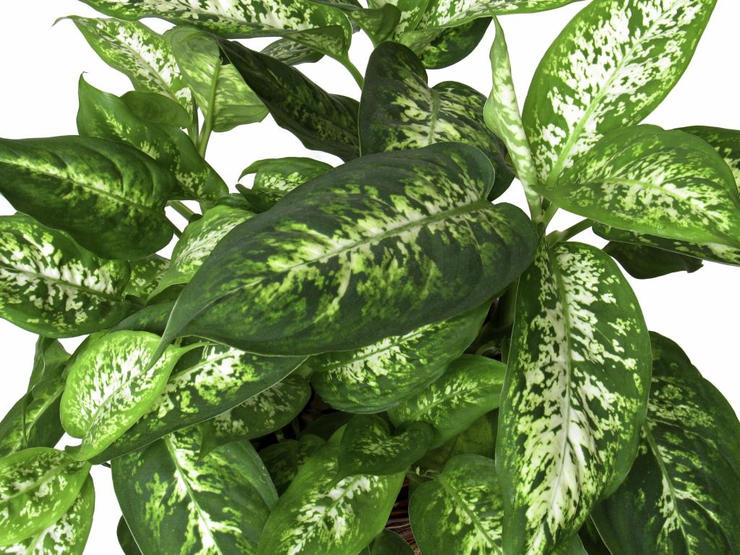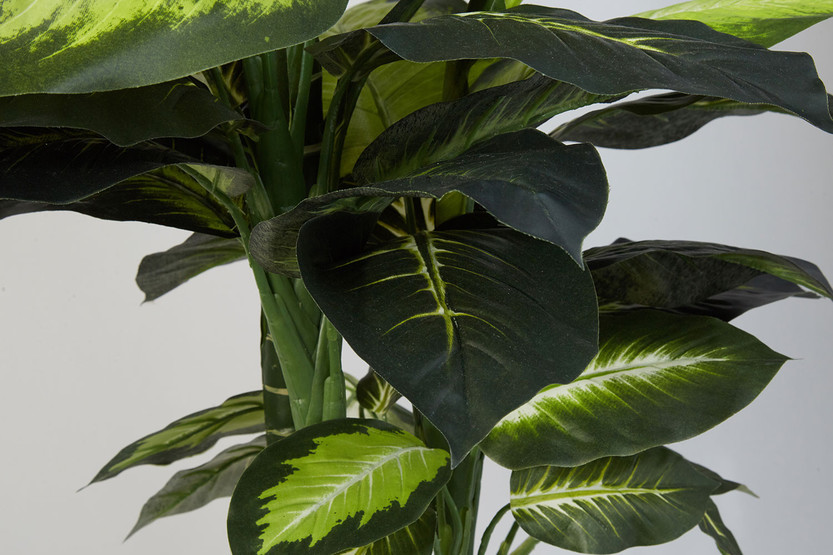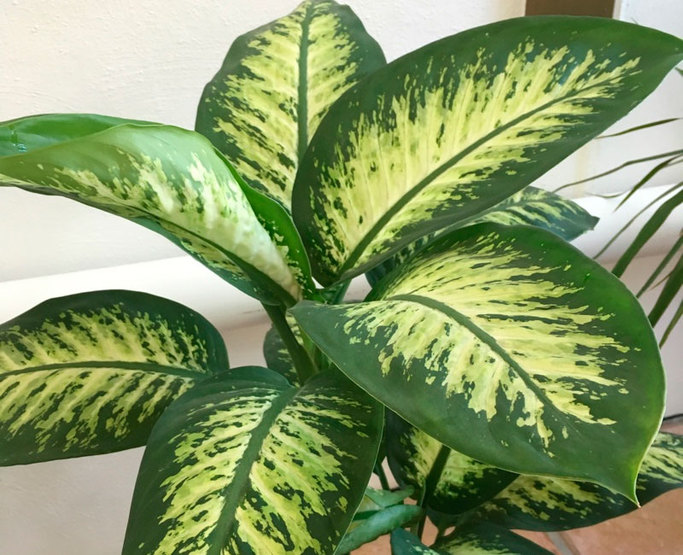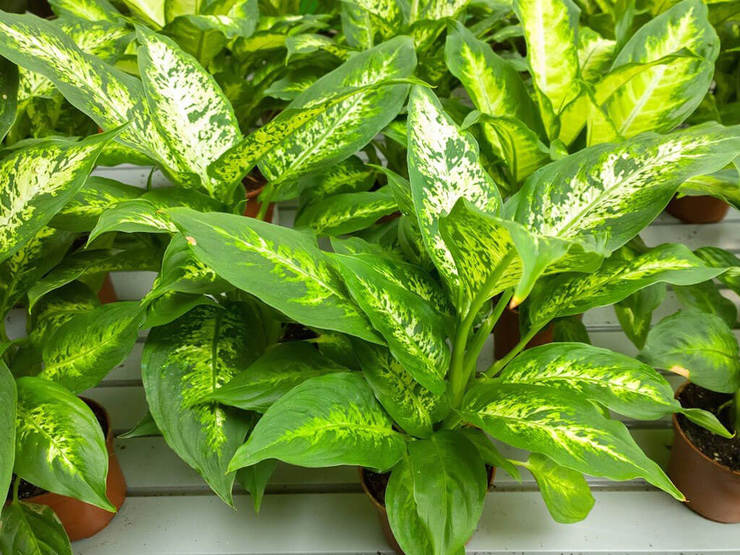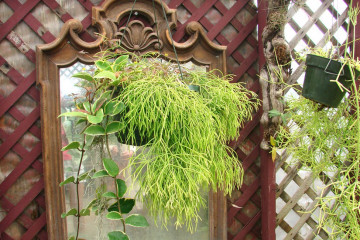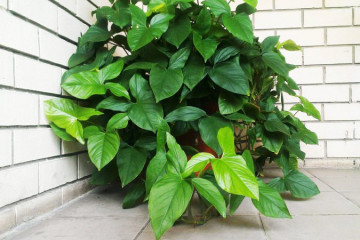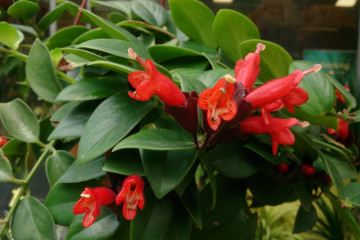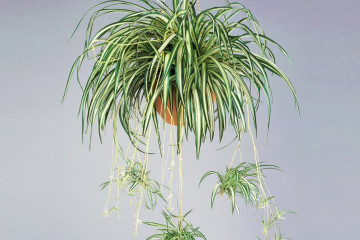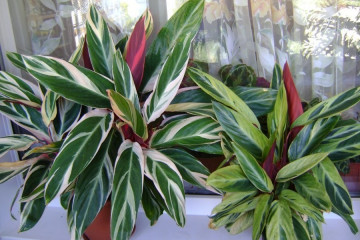Dieffenbachia - home care, reproduction
Content:
Dieffenbachia is very popular with domestic florists, because it looks impressive and is unpretentious in care. However, this flower should not be grown in a house where there are children and pets - the sap of the plant is poisonous. When caring for a flower, the necessary precautions should be strictly observed.
About the history of appearance
The flower owes its name to German botanists. For the first time this species was discovered in the wild by IF Dieffenbach. Later, varieties for cultivation at home were artificially bred.
Appearance
Dieffenbachia belongs to the Aroid family. It grows wild in South America. The main features of the species:
- Fleshy large dark green leaves with light green stripes;
- Tall but fragile stem;
- A large number of lateral processes;
- Rapid growth and development.
There are several varieties that are recommended for home cultivation.
Common varieties
The most common varieties are Spotted (large-leaved bush variety), White Flame and Seguina, and Mix. They tolerate temperature extremes well, and are resistant to diseases and pests. You can buy planting material in specialized stores or from amateur flower growers.
Caution! The plant is poisonous
The plant itself is not hazardous to health. However, if you cut a leaf or stem, juice will begin to flow out of it. This juice irritates the skin and mucous membranes, can provoke allergies or even Quincke's edema. Therefore, when performing pruning or transplanting, in no case should mechanical damage be caused to the flower.
Home care
Dieffenbachia care at home means proper watering and intensive feeding. Also, the list of mandatory events includes:
- Maintaining proper temperature conditions;
- Fight against diseases, pests and parasites;
- Pruning;
- Preparing for winter.
Watering requires special attention. It should be moderate, otherwise the stem will quickly rot.
Temperature
The recommended room temperature is above 17 degrees, the ideal option is from 20 degrees. When it's freezing outside, it is strictly forbidden to ventilate the room, because dieffenbachia does not tolerate drafts. For the time of airing, the flower is taken out to another room.
Lighting
Experts do not advise placing the plant on the south window, because it does not tolerate direct sunlight. The lighting should be good, but diffuse. If the flower stays in the shade for a long time, the stem will become very long and fragile.
Watering
During the period of intensive growth and development, abundant watering is recommended. However, when growth is slowing down, the moisture supply must be reduced. During the period of physiological dormancy (winter, late autumn), watering the soil in a pot is minimized. Failure to follow these rules can lead to the death of the flower or its long top.
Spraying
On the large, fleshy leaves of an adult plant, dust constantly accumulates in the center and at the edges, so at least once a week the plant needs to do a warm "shower". Dieffenbachia can be sprayed with water at room temperature from a spray bottle. This procedure is an excellent prevention of diseases, pests and parasites.
Humidity
In the wild, the flower grows in the tropical rainforests of South and Central America, so you need to constantly maintain high humidity in the room. In winter, when the air is dry due to the operation of the central heating, you can place a pot filled with warm water on the windowsill. The moisture will evaporate, having a beneficial effect on the growth and development of dieffenbachia.
Priming
The flower is undemanding to the composition of the soil, so it is best to use ordinary soil for indoor plants. It is not worth bringing the earth from the street - it often contains dangerous pests and parasites. Charcoal can be added to the pots as an adsorbent.
Top dressing
Since the plant develops intensively, dieffenbachia must be fed daily. For this, any complex fertilizers for indoor flowers are well suited. The plant needs most of all nitrogen, potassium and phosphorus. To replenish the calcium deficiency, you can add powdered eggshells to the soil.
Winter care, during dormancy
With the onset of cold weather, the plant enters a period of physiological dormancy. If autumn turned out to be warm and sunny, the room constantly maintains a high air temperature, this period comes later. On the other hand, with a lack of light and heat, the flower can “retire” earlier than usual. Before leaving for the winter, it is recommended to prune Dieffenbachia. In order for the flower to endure the cold period well, it is necessary:
- Reduce watering, but loosen the soil regularly;
- Periodically arrange a warm "shower" for the flower from a spray bottle;
- Inspect the leaves and stems as often as possible so as not to miss the appearance of dangerous diseases or pests (parasites);
- Before wintering, carry out pruning in order to form the crown and get rid of dry, deformed, diseased shoots and leaves.
The end of winter is a great time for a transplant. Usually it is carried out in the third - fourth decade of February. However, if February turned out to be frosty, and it is cold in the apartment, it is better to wait until the real heat comes. The main thing is not to transplant the flower in extreme heat.
Pruning
Dieffenbachia is a flower that grows very quickly and at the same time has a fragile, brittle stem, therefore, improper crown formation and neglect of pruning, transplanting can become the causes of the death of the plant. Pruning should be done regularly as the trunk and leaves grow. Before pruning and replanting dieffenbachia, you need to make sure that the plant is absolutely healthy, not weakened by diseases and pests.
Care for dieffenbachia is not difficult, but pruning is a troublesome business that requires certain skills. The step-by-step algorithm of the procedure is as follows:
- Wear gloves to protect your hands from the milky juice of dieffenbachia;
- Armed with a sharpened knife, carefully cut off the top with leaves. A small compact stump should remain;
- Cover the cut with plastic wrap;
- Reduce watering. When the kidneys begin to awaken, the supply of moisture will need to be reactivated.
A cut trunk with leaves, if it is completely healthy, is placed in water and waited for it to take root again. Then the plant can be transplanted. If the trunk is affected by diseases (pests), it is burned, otherwise re-infection is possible. You can also divide the cuttings into several parts and then use these cuttings for propagation.
Pruning is known to have significant anti-aging effects. The plant begins to develop faster. Sometimes, after properly pruning, dieffenbachia suddenly begins to bloom, its flowering is a rather rare phenomenon even in natural conditions.
Reproduction
Every indoor plant lover should know how to propagate dieffenbachia. There are several ways:
- Seeds;
- By cuttings;
- Layers;
- By dividing the roots.
The fastest and easiest of them is to propagate and root with cuttings.
Germinating seeds
Dieffenbachia seed propagation is a long and troublesome process. In addition, seeds often have poor germination, so this method is not of interest to amateur flower growers. It is used only for breeding new varieties by professional breeders.
Rooting cuttings
Many people know how dieffenbachia reproduces by rooting cuttings. The flower can be cut in water at room temperature; a biological growth stimulant can be added to speed up the process. After about 7-10 days, roots appear. When their length reaches 20 mm, the cuttings are planted in the ground.
Air layering
This is one of the most common breeding methods for dieffenbachia. Before you propagate dieffenbachia at home using layering, you need to make sure that the shoots are healthy and strong, not affected by diseases and pests.
Other options
Another common breeding method is by dividing the roots. It is usually practiced when transplanting. The flower is taken out of the pot, the decayed parts of the roots are removed, one copy is divided into several fragments with a sharp knife and the resulting parts are dried on a newspaper. After 24 hours, each part is seated in its own pot. For disinfection of the roots, experts recommend using a weak solution of potassium permanganate or activated carbon. These drugs help fight fungus well.
Transfer
Before transplanting dieffenbachia, you need to prepare a new pot. For dieffenbachia, transplanting is associated with a great risk of affecting the root system. Step-by-step transplant algorithm:
- Pour a mixture of turf, peat and sand into a new pot;
- Carefully remove the dieffenbachia together with the earth from the old vessel;
- Carefully inspect the roots, cut and disinfect them if necessary;
- Transplant the flower to a new location, slightly deepening the stem.
Do not transplant during the cold season. The best time for this procedure is spring. After a correctly performed transplant, the flower begins to grow faster and more actively.
Possible growing problems
All amateur flower growers know how to care for dieffenbachia. However, not everyone understands why the plant can get sick. The most common symptoms of trouble are:
- Yellowing of the leaves;
- Pale color of leaves;
- Drying;
- Falling foliage.
Each of these disorders has its own cause, so they need to be treated differently.
Leaves turn yellow
Not everyone knows why dieffenbachia leaves turn yellow. This is most often caused by root decay. Reducing watering in most cases helps to save the situation.Also, the leaves can turn yellow if you plant dieffenbachia in a tight pot.
Leaves turn pale
If dieffenbachia leaves turn yellow, the reasons may be different. If the leaves turn pale, it is most often caused by a lack of nutrients. As an "ambulance", the plant needs fertilizing with complex mineral fertilizers.
The tips of the leaves dry
Drying of the tips is an alarming symptom, signaling stem and root problems. In this case, you can save the flower by transplanting and removing some of the diseased (rotten) roots.
The lower leaves fall
If the lower leaves began to fall off, curl and dry, a fungal or viral infection is to blame. To combat the disease, you can use industrial fungicides, and pruning also has a healing effect.
Pests
Dieffenbachia rarely becomes a prey for pests, insects are repelled by poisonous milky juice. However, the plant can be attacked by a scale insect. It can leave mucus on the leaves, as if the flower "cries" with real tears. Spraying should be used to combat it. Also, the scale insect loves dust, so you need to wipe the leaves with a damp cloth as often as possible and arrange a powerful "shower" for the flower.
Other problems
Other problems include viral leaf mosaic disease. The foliage changes its color, whitish and yellow spots appear on it. Destroying and burning affected leaves and stems will help reanimate the plant, no matter how sick it may seem.
This flower is good because it quickly adapts to any conditions. However, flower growers should be aware of its toxicity; such a plant is better suited for the office, and not for the home. Carrying out care, you should pay special attention to the correct feeding. The rapid development of the plant at home largely depends on it.
